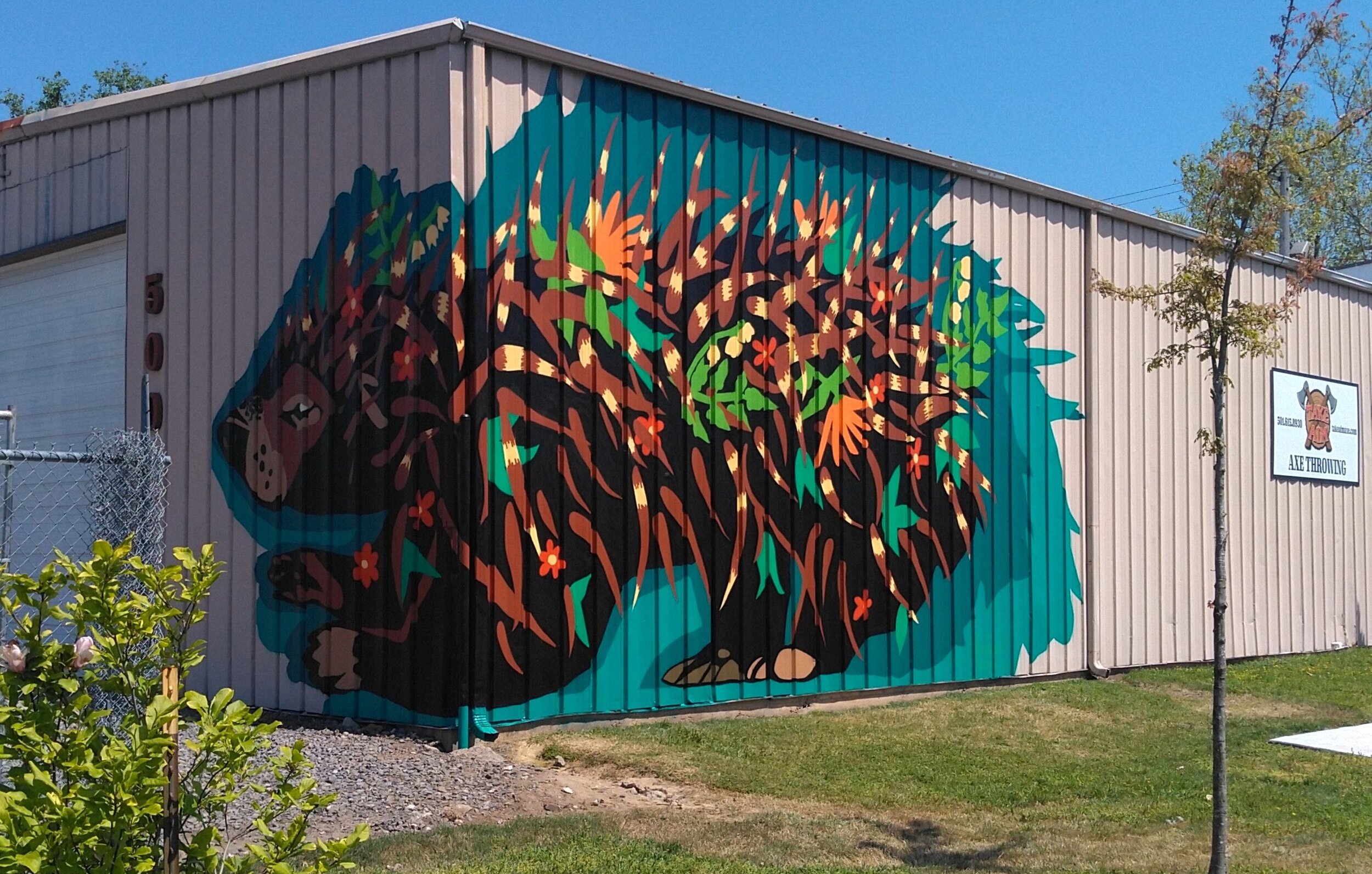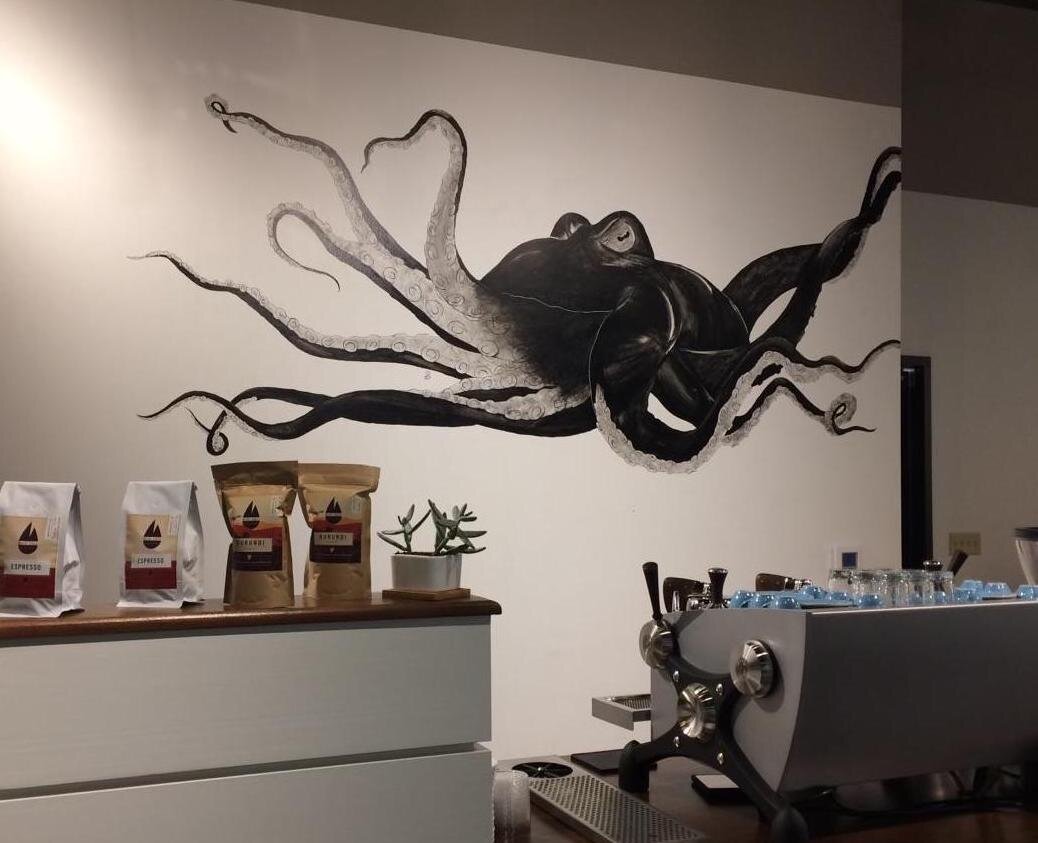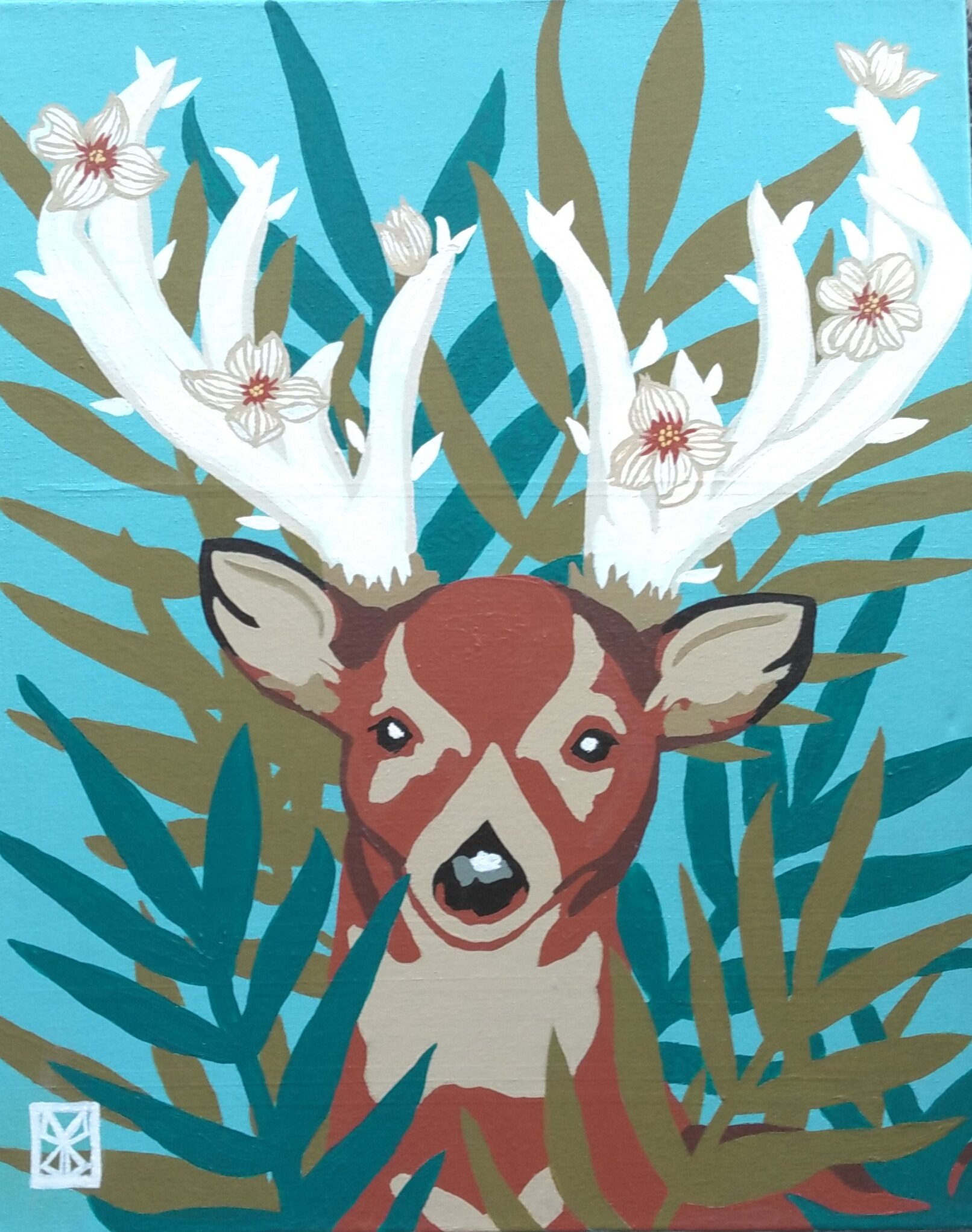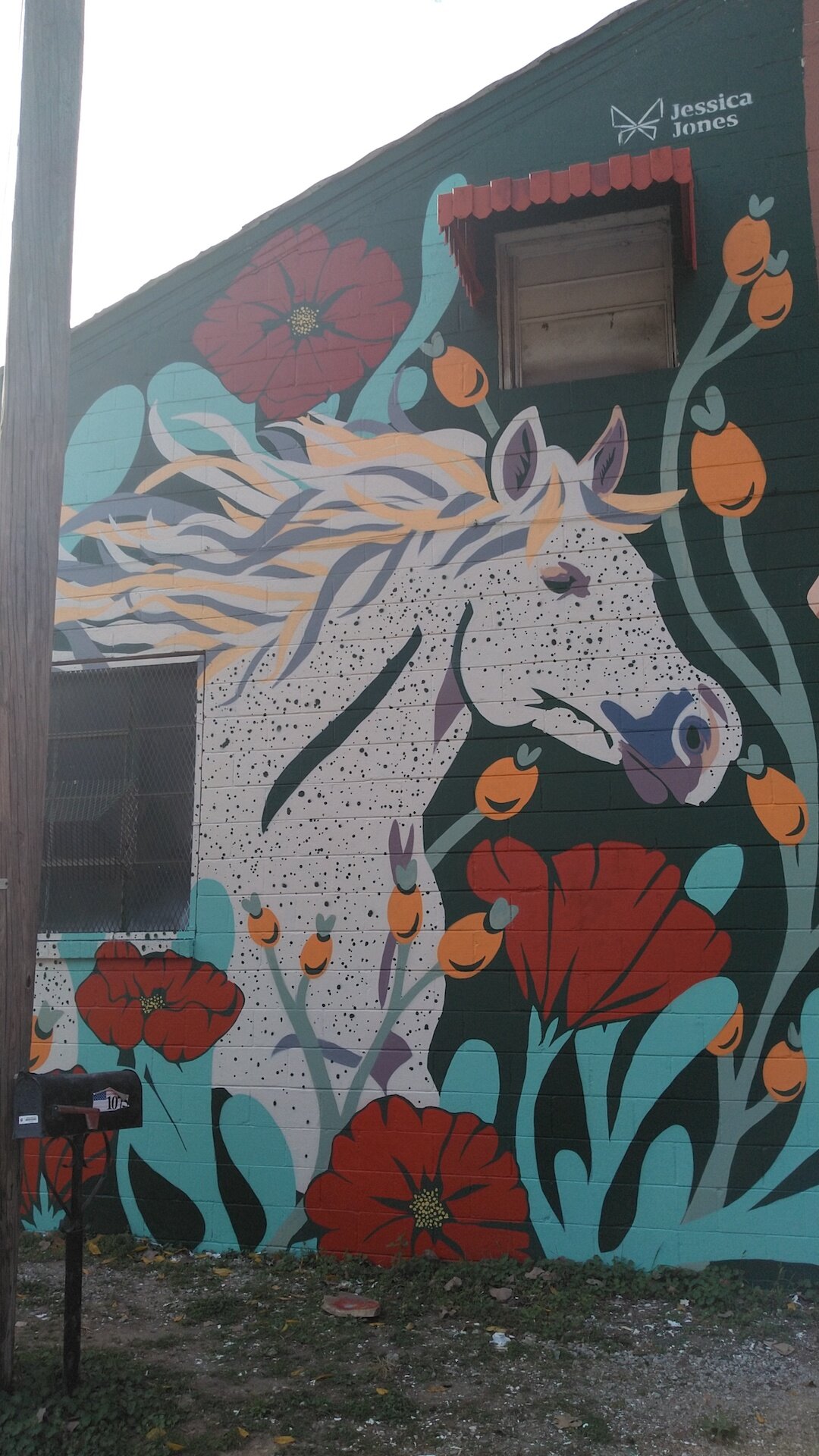Interview with artist Jessica Jones
Jessica Jones is a muralist living in Conway, Arkansas. She loves the outdoors and takes inspiration from it. Her cheerful and colorful murals are always a celebration. More of her work can be found at her website artbyjessicajones.com.


AAS: Jessica, you are a fairly recent transplant to Arkansas. What brought you here?
JJ: Yes, I’ve lived in Arkansas about 10 years. I grew up in Florida, an Italian American, born Jessica Sabatino. I moved to Tucson, Arizona for college when I was 20. I married my first husband there and became Jessica Jones, and later moved to Colorado for work. The recession of the time put us out of work, and we moved to Arkansas, which is where my late husband grew up, and where we had family and support for that difficult season. After the birth of my second child, I became a full time stay at home Mom. After the unexpected death of my husband 4 years ago I started doing art full time as a way to support my family. I recently remarried and I am excited for the next chapters of my life here in the natural state.
AAS: It takes more than just talent to be a full-time artist. You must have tremendous discipline. How do you manage that?
JJ: Yes indeed! I always tell people most of my success is from doing what I say I’m going to do when I say I’m going to do it, not from divine talent. I suppose it is rooted out of necessity. My two children mean everything to me, and it’s not easy trying to support yourself much less a family as an artist. We have a culture that doesn’t view art with as much value as other pursuits. To make a living as an artist you have to be impeccable in your work ethic and integrity. It was also important to me to set an example to my children. Bad things can happen to you in life, but you still don’t give up on your passions.
AAS: Let’s talk about some of your murals. You just completed a wonderful wall, Hope, inside CARTI. How did that come about?
Hope, at CARTI, Little Rock, Arkansas
JJ: That mural came about after someone reached out from the hospital about wanting something to brighten up the cafe. Having lost family members and friends to cancer I was honored for the opportunity. It was difficult logistically, I had to work after 3:30 in the afternoon when they didn’t have patients. I usually end my day at that time and pick up my kids from school. I was picking them up, taking them with me, and driving 30 minutes to the hospital daily to paint in the evenings. It definitely would not have been possible without so many friends coming and helping paint and my awesome assistant Travis.
AAS: You created a large outdoor mural in Conway titled The Pollinator and it received a lot of press. It is spectacular! Would you talk about work?
The Pollinator, spray paint, latex paint, Conway, Arknasas
JJ: Thank you! That mural was the dream of the building owner Pete Tanguay. I was totally inspired by his vision to bring nature and wildlife to the city landscape. Pollinators are essential to life as we know it and it is my job as an artist to shed light on that.
This larger mural took about a month to complete. It is sometimes hard to estimate how long a mural will take because there are so many moving parts. A week of rain can certainly put you behind schedule. Similarly, you have to be aware of freezing temperatures as it will comprise the integrity of water based paint. I usually use a lot of spray paint on exterior walls, which allows me to move much faster, as opposed to brushing with latex, which is a more meditative process.
AAS: You did another very large mural in Jacksonville titled Together We Rise. It is more difficult painting over brick?
JJ: I really enjoyed that wall. It is my largest one yet at over 160 ft long. It is on the side of a huge and amazing flea market – seriously, come for the mural, stay for the flea market. We projected loose outlines of the design in sections and then used a reference image to pull it together. The city of Jacksonville wanted imagery that referenced their past and where they want to go in the future, moving towards understanding and progress. I liked the way a variety of birds referenced to this, but also can be interpreted individually by the viewer. Brick is definitely more difficult than a smooth surface, but I don’t mind it. As an artist whose main canvas is walls, it’s just par for the course. Now corrugated metal is another story, and hands down my least favorite, but even that is doable.
Together We Rise, spray paint and latex paint, Jacksonville, Arkansas
AAS: Well, Feelin’ Foxy is one of your murals done on corrugated metal. How do you deal with such an uneven surface and an already complicated and elaborate design?
Feelin’ Foxy, spray paint and latex paint, North Little Rock, Arkansas
JJ: I usually try and simplify the details to a degree. Super fine small details can tend to get lost in the wave of the walls. Instead I attempt to ‘ride the wave’ so to speak and design something that can flow along it easier so it’s not fighting with the texture. You definitely have to choose which angle to viewer is supposed to look at it, which for me is usually center and straight on. With Feelin’ Foxy I chose this design for that wall because the wall is very long is comparison to height. The foxes play adds movement along the distance of the wall and the sheer size of the foxes allows them to work with the wall, and not against. Admittedly as that was my first corrugated wall I had to pull texture out of some of the floral elements. The excess texture proved to be incompatible for the surface.
AAS: Another mural you created in Conway is at the Brick Room Event Center entrance. It is called Life Is A Flower.
LIfe Is A Flower, latex paint, Conway, Arkansas
JJ: Ah yes. That one has always been a personal and fan favorite. That wall was completely done freehand in chalk on the wall, erasing and changing to my liking. I sketched it out on the day of my first date with my now husband. I like to think it was created with hope, and a turning point of my rise from the ashes. It also felt the truest to me, and a compass for my personal style. We got married in front of the most recent large floral canvas I completed. While I was painting it, a passerby in the studio said it looked like the Brick Room floral, not knowing I had painted it. It felt as though things had come full circle.
Untitled, 10’ x 6’, acrylic on canvas
AAS: Some of your canvas work is still quite large. Are those mostly commissions too?
JJ: Some are commissions and some are personal. The large canvas I recently painted and spoke about was purely personal (it remains unnamed). It was definitely healing to take time to explore my own creative expression without bounds. I do tend to like painting big. I suppose it’s my comfort zone. I love the way you can really zoom in on small details when they are blown up to such big sizes. Still, I definitely enjoy working outside. I love being In the sun and being among the community. I often times get to build relationships with people living outside, which brings an added layer of connectedness to the communities I paint in.
AAS: Your images almost always include flowers and wildlife. Are you an outdoorsy nature person?
JJ: Oh definitely. Our family loves hiking, kayaking, biking, camping. You name it, we love getting out and being with nature. I live on 8.5 acres in the woods and am working on constructing my own Walden Pond. So, if I fall off the grid you know what happened.




AAS: What is the process to get a commission to do those large outdoor murals?
JJ: So, usually I ask a series of questions. What are they looking to achieve through their mural? What are they inspired by? Which of my previous works are they drawn to? People vary as to how specific their vision is, so for some walls I have more creative freedom than others. I do try to refer commissions to other artists if they are requests completely outside of my style.
AAS: You mentioned you assistant Travis earlier. Do you have team that goes onsite to help you?
JJ: I have Travis and lots of friends I might reach out to, as needed, for backup. Many walls have been done solo and many with lots of help. You just have to be flexible and prepared to do what it takes!
AAS: I have interviewed several mural painters for the blog – Sasha Rayevskiy, Matt McLeod, Kevin Kresse, Robin Tucker, Meikel Church and others I’m sure. Is it a close-knit community of artists?
JJ: For sure! Covid has made in person relationships harder to facilitate, but I have never felt anything but support from other artists in the community. I certainly love sharing other artists work and seeing the way they contribute to the urban landscape. We will recommend walls to one another if a client is looking for something another artist specializes in. We’re all in this together and we have to work together and support each other to keep the creative movement alive.



